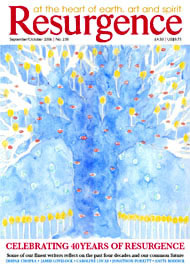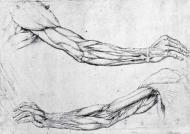I HAVE BEEN fascinated by Leonardo da Vinci's science for over three decades, and over the years have referred to it in several of my writings, without, however, studying his extensive notebooks in any detail. The impetus to do so came in the mid-1990s, when I saw a large exhibition of Leonardo's drawings at the Queen's Gallery at Buckingham Palace in London. As I gazed at those magnificent drawings which juxtaposed, often on the same page, architecture and human anatomy, turbulent water and turbulent air, water vortices, the flow of human hair and the growth patterns of grasses, I realised that Leonardo's systematic studies of living and non-living forms amounted to a science of quality and wholeness - fundamentally different from the mechanistic science of Galileo and Newton.
Having explored the modern counterparts to Leonardo's approach, known as complexity theory and systems theory, in several of my previous books, I felt that it was now time for me to study Leonardo's notebooks in earnest and to evaluate his scientific thought from the perspective of the most recent advances in modern science. When I embarked on this project, I discovered to my great surprise that there are very few books on Leonardo's science, even though he left thousands of pages full of detailed descriptions of his experiments and long analyses of his findings. Moreover, most authors who have discussed Leonardo's scientific work have looked at it through Newtonian lenses, which has often prevented them from understanding its essential nature.
Only now, as the limits of Newtonian science are becoming all too apparent and the mechanistic Cartesian worldview is giving way to an organic and ecological view not unlike Leonardo's, can we begin to appreciate the full power of his science and its great relevance for our modern era.
Studying Leonardo from this perspective not only allows us to recognise his science as a solid body of knowledge, but also shows why it cannot be understood without his art, nor his art without the science.
WHEN THE YOUNG Leonardo received his training as painter, sculptor and engineer in Florence, the worldview of his contemporaries was still entangled in medieval thinking. Science in the modern sense, as a systematic empirical method for gaining knowledge about the natural world, did not exist. Knowledge about natural phenomena, some accurate and some inaccurate, had been handed down by Aristotle and other philosophers of antiquity, and was fused with Christian doctrine by the Scholastic theologians who presented it as the officially authorised creed and condemned scientific experiments as subversive, seeing any attack on Aristotle's science as an attack on the Church. Leonardo broke with this tradition: "First I shall do some experiments before I proceed farther, because my intention is to cite experience first and then with reasoning show why such experience is bound to operate in such a way. And this is the true rule by which those who speculate about the effects of nature must proceed."
One hundred years before Galileo and Bacon, Leonardo single-handedly developed a new empirical approach, involving the systematic observation of nature, reasoning, and mathematics - in other words, the main characteristics of what is known today as the scientific method. He fully realised that he was breaking new ground. He humbly called himself omo sanza lettere ('an unlettered man'), but with some irony and with pride in his new method, seeing himself as an "interpreter between nature and humans".
Leonardo's approach to scientific knowledge was visual, and it was the approach of a painter. "Painting", he declared, "embraces within itself all the forms of nature." I believe that this statement is the key to understanding Leonardo's science. He asserts repeatedly that painting involves the study of natural forms, and he emphasises the intimate connection between the artistic representation of those forms and the intellectual understanding of their intrinsic nature and underlying principles.
Painting, for Leonardo, is both an art and a science - a science of natural forms, of qualities, quite different from the quantitative, mechanistic science that would emerge 200 years later. Leonardo's forms are living forms, continually shaped and transformed by underlying processes. Throughout his life he studied, drew and painted the rocks and sediments of the Earth, shaped by water; the growth of plants, shaped by their metabolism; and the anatomy of the animal body in motion.
Nature as a whole was alive for Leonardo, and he saw the patterns and processes in the macrocosm (the Earth) as being similar to those in the microcosm (the human body). At the most fundamental level, he always sought to understand the nature of life. This has often escaped earlier commentators because until recently the nature of life was defined by biologists only in terms of cells and molecules, to which Leonardo, living two centuries before the invention of the microscope, had no access. But today, a new systemic understanding of life is emerging at the forefront of science - an understanding in terms of metabolic processes and their patterns of organisation; and those are precisely the phenomena which Leonardo explored throughout his life.
In the macrocosm, the main themes of Leonardo's science were the movements of water and air, the geological forms and transformations of the Earth, and the botanical diversity and growth patterns of plants. In the microcosm, his main focus was on the human body - its beauty and proportions, the mechanics of its movements, and how it compared to other animal bodies in motion, in particular the flight of birds.
Unlike Descartes, Leonardo never thought of the body as a machine, even though he was a brilliant engineer who designed countless machines and mechanical devices. "Nature cannot give movement to animals without mechanical instruments," he ex-plained, but that did not imply for him that living organisms were machines. It only implied that, in order to understand the movements of the animal body, he needed to explore the principles of mechanics, which he did for many years in a thorough and systematic way. He clearly understood that the means of the body's movements were mechanical, but that their origin lay in the soul, the nature of which was not mechanical but spiritual.
Leonardo did not pursue science and engineering in order to dominate nature, as Francis Bacon did a century later. He had a deep respect for all life, a special compassion for animals, and great awe and reverence for nature's complexity and abundance. While being a brilliant inventor and designer himself, he always thought that nature's ingenuity was vastly superior to human design, and he felt that we would be wise to respect nature and learn from her. "Though human ingenuity in various inventions uses different instruments for the same end," he declared, "it will never discover an invention more beautiful, easier, or more economical than nature's, because in her inventions nothing is wanting and nothing is superfluous."
THIS ATTITUDE OF seeing nature as a model and mentor is now being rediscovered in the practice of ecological design. Like Leonardo 500 years ago, ecodesigners today study the patterns and flows in the natural world and try to incorporate the underlying principles into their design processes. Underlying such an attitude of appreciation and respect for nature is a philosophical stance that does not view humans as standing apart from the rest of the living world but rather as being fundamentally embedded in, and dependent upon, the entire community of life in the biosphere.
Leonardo's synthesis of art and science is infused with this deep ecological awareness. In my view, this is the main reason why his legacy is immensely relevant to our time. As we recognise that our sciences and technologies have become increasingly narrow in their focus, unable to understand our multi-faceted problems from an interdisciplinary perspective, and dominated by corporations more interested in financial rewards than in the well-being of humanity, we urgently need a science that honours and respects the unity of all life, recognises the fundamental interdependence of all natural phenomena, and reconnects us with the living Earth.
What we need today is exactly the kind of science Leonardo da Vinci anticipated and outlined 500 years ago.
Leonardo da Vinci's drawings are currently being shown in two major exhibitions, at the Victoria & Albert Museum in London (September 2006-January 2007) and at the Uffizi Gallery in Florence (March 2006-January 2007).








